Glucose-elevating agents raise blood level of glucose when severe hypoglycemia occurs at <40 mg/dL. Two agents are used to elevate glucose: diazoxide and glucagon.
Table of Contents
- Glucose-Elevating Agents: Generic and Brand Names
- Therapeutic Action
- Indications
- Pharmacokinetics
- Contraindications and Cautions
- Adverse Effects
- Interactions
- Nursing Considerations
- Practice Quiz: Glucose-Elevating Agents
- Recommended Resources
- See Also
- References and Sources
Glucose-Elevating Agents: Generic and Brand Names
Here is a table of commonly encountered glucose-elevating agents, their generic names, and brand names:
- Glucose-elevating agents
- diazoxide (Proglycem, Hyperstat)
- glucagon (GlucaGen)
Therapeutic Action
The desired and beneficial action of glucose-elevating agents:
- Increasing blood glucose by decreasing insulin release and accelerating the breakdown of glycogen in the liver to release glucose.
Indications
Glucose-elevating agents are indicated for the following medical conditions:
- Diazoxide is an oral management of hypoglycemia; intravenous use for management of severe hypertension.
- Glucagon is used to counteract severe hypoglycemic reactions.
Pharmacokinetics
Here are the characteristic interactions of glucose-elevating agents and the body in terms of absorption, distribution, metabolism, and excretion:
| Route | Onset | Peak | Duration |
| IV | 1 min | 15 min | 9-20 min |
| T1/2: 3-10 min Metabolism: liver Excretion: bile, urine |
Contraindications and Cautions
The following are contraindications and cautions for the use of glucose-elevating agents:
- Diazoxide is contraindicated with known allergies to sulfonamides or thiazides.
- Pregnancy and lactation. Associated with adverse effects to fetus and baby.
- There are no adequate studies on glucagon and pregnancy, so use should be reserved for those situations in which the benefits to the mother outweigh any potential risks to the fetus.
- Caution should be used in patients with renal or hepatic dysfunction or cardiovascular disease.
Adverse Effects
Use of glucose-elevating agents may result to these adverse effects:
- Glucagon is associated with GI upset, nausea, and vomiting.
- Diazoxide is associated with vascular effects, including hypotension, headache, cerebral ischemia, weakness, heart failure, and arrhythmias. This is because diazoxide has the ability to relax arteriolar smooth muscle.
Interactions
The following are drug-drug interactions involved in the use of glucose-elevating agents:
- Diazoxide with thiazide diuretics can increase risk of toxicity because these two are structurally the same.
- Glucagon with oral anticoagulants will increase anticoagulation effects.
Nursing Considerations
Here are important nursing considerations when administering glucose-elevating agents:
Nursing Assessment
These are the important things the nurse should include in conducting assessment, history taking, and examination:
- Assess for contraindications and cautions: history of allergy, renal and hepatic dysfunction, pregnancy to avoid adverse effects.
- Perform a complete physical assessment to establish a baseline before beginning therapy, monitor effectiveness of therapy, and evaluate for any potential adverse effects during therapy.
- Assess orientation and reflexes and baseline pulse, blood pressure, and adventitious sounds to monitor the effects of altered glucose levels, and abdominal sounds and function, which could be altered by these drugs.
- Monitor blood glucose levels as ordered to assess the effectiveness of the drug and patient response to treatment.
- Monitor the results of laboratory tests, including urinalysis, to evaluate for glucosuria, serum glucose to evaluate response to therapy, and renal and liver function tests to determine the need for possible dose adjustment or identify possible toxic effects.
Nursing Diagnoses and Care Planning
Here are some of the nursing diagnoses that can be formulated in the use of this drug for therapy:
- Risk for unstable blood glucose related to ineffective dosing of the drug
- Imbalanced nutrition: more than body requirements related to metabolic effects
Nursing Implementation with Rationale
These are vital nursing interventions done in patients who are taking glucose-elevating agents:
- Monitor blood glucose levels to evaluate the effectiveness of the drug.
- Have insulin on standby during emergency use to treat severe hyperglycemia if it occurs as a result of overdose.
- Monitor nutritional status to provide nutritional consultation as needed.
- Monitor patients receiving diazoxide for potential cardiovascular effects, including blood pressure, heart rhythm and output, and weight changes, to avert serious adverse reactions.
- Provide comfort measures to help patient cope with drug effects.
- Provide patient education about drug effects and warning signs to report to enhance patient knowledge and to promote compliance.
Evaluation
Here are aspects of care that should be evaluated to determine effectiveness of drug therapy:
- Monitor patient response to therapy (stabilization of blood glucose levels).
- Monitor for adverse effects (hyperglycemia and GI distress).
- Evaluate patient understanding on drug therapy by asking patient to name the drug, its indication, and adverse effects to watch for.
- Monitor patient compliance to drug therapy.
Practice Quiz: Glucose-Elevating Agents
Here are some practice questions for this study guide. Please visit our nursing test bank page for more NCLEX practice questions.
1. Severe hypoglycemia is set to occur and would need a dose of glucose-elevating agents at which blood glucose level?
A. 30 mg/dL
B. 65 mg/dL
C. 50 mg/dL
D. 75 mg/dL
1. Answer: A. 30 mg/dL
Glucose-elevating agents raise blood level of glucose when severe hypoglycemia occurs at <40 mg/dL.
2. Glucose-elevating agents exert their actions by:
A. Delaying the excretion of glucose
B. Decreasing insulin release
C. Delaying the breakdown of glycogen in the liver to release more glucose
D. Transforming into synthetic glucose molecules that the body can use in times of severe stress
2. Answer: B. Decreasing insulin release
The desired and beneficial action of glucose-elevating agents is increasing blood glucose by decreasing insulin release and accelerating the breakdown of glycogen in the liver to release glucose.
3. Glucagon is commonly associated with which adverse effects?
A. GI upset
B. Arrhythmia
C. Skin rashes
D. Hypokalemia
3. Answer: A. GI upset
Glucagon is associated with GI upset, nausea, and vomiting.
4. Diazoxide is commonly associated with which adverse effects?
A. Hypotension and headache
B. Myalgia and arthralgia
C. Jaundice
D. Oliguria
4. Answer: A. Hypotension and headache
Diazoxide is associated with vascular effects, including hypotension, headache, cerebral ischemia, weakness, heart failure, and arrhythmias. This is because diazoxide has the ability to relax arteriolar smooth muscle.
5. Which of the following drugs is to be avoided in patients taking diazoxide to prevent toxicity?
A. ACE inhibitors
B. Thiazide diuretics
C. Phenothiazines
D. Antacids
5. Answer: B. Thiazide diuretics
Diazoxide with thiazide diuretics can increase risk of toxicity because these two are structurally the same.
Recommended Resources
Our recommended nursing pharmacology resources and books:
Disclosure: Included below are affiliate links from Amazon at no additional cost from you. We may earn a small commission from your purchase which will help support us. Thank you! For more information, check out our privacy policy.
Pharm Phlash! Pharmacology Flash Cards #1 BEST SELLER!
Test-yourself review cards put critical clinical information for nearly 400 of the top generic medications at your fingertips. And, you can count on them for accuracy, because each card is based on content from Davis’s Drug Guide for Nurses. Increase your test scores in pharmacology class.
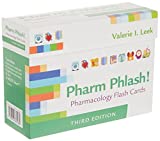
Focus on Pharmacology (8th Edition)
Focus on Nursing Pharmacology makes challenging concepts more approachable. Engaging learning features cultivate your clinical application, critical thinking and patient education capabilities. This updated 8th edition builds on your knowledge of physiology, chemistry and nursing fundamentals to help you conceptualize need-to-know information about each group of drugs.
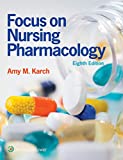
Pharmacology Made Incredibly Easy (Incredibly Easy! Series®)
Nursing pharmacology guide offers step-by-step guidance so you can grasp the fundamentals in enjoyable Incredibly Easy style. This is the perfect supplement to class materials, offering solid preparation for NCLEX® as well as a handy refresher for experienced nurses. Colorfully illustrated chapters offer clear, concise descriptions of crucial nursing pharmacology concepts and procedures.
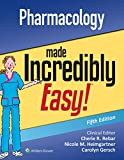
Lehne’s Pharmacology for Nursing Care (11th Edition)
The Eleventh Edition of Lehne’s Pharmacology for Nursing Care provides a thorough understanding of key drugs and their implications for nursing care. This text, written by renowned nursing educators, helps you comprehend and apply pharmacology principles. A clear and engaging writing style simplifies complex concepts, making even the most challenging pharmacology content enjoyable. We recommend this book if you want a comprehensive nursing pharmacology guide.
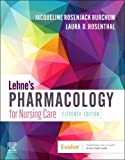
Nursing Drug Handbook
Nursing2023 Drug Handbook delivers evidence-based, nursing-focused drug monographs for nearly 3700 generic, brand-name, and combination drugs. With a tabbed, alphabetical organization and a “New Drugs” section, NDH2023 makes it easy to check drug facts on the spot.
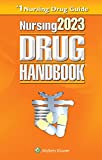
Pharmacology and the Nursing Process
The 10th edition of Pharmacology and the Nursing Process offers practical, user-friendly pharmacology information. The photo atlas contains over 100 unique illustrations and photographs depicting drug administration techniques. Updated drug content reflects the most recent FDA drug approvals, withdrawals, and therapeutic uses.
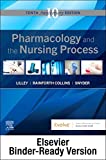
Mosby’s Pharmacology Memory NoteCards: Visual, Mnemonic, and Memory Aids for Nurses
The 6th edition of Mosby’s Pharmacology Memory NoteCards: Visual, Mnemonic, & Memory Aids for Nurses incorporates illustrations and humor to make studying easier and more enjoyable. This unique pharmacology review can be utilized as a spiral-bound notebook or as individual flashcards, making it ideal for mobile study.
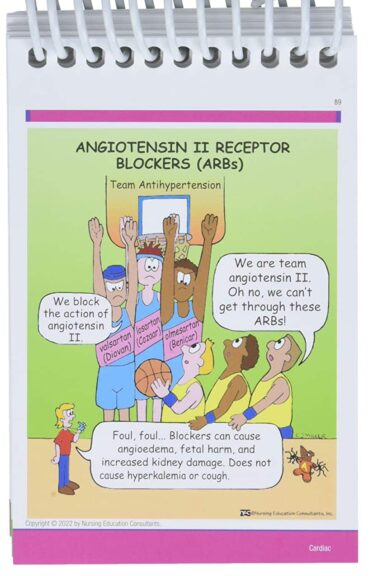
See Also
Here are other nursing pharmacology study guides:
- Nursing Pharmacology – Study Guide for Nurses
Our collection of topics related to nursing pharmacology - Pharmacology Nursing Mnemonics & Tips
These nursing mnemonics aim to simplify the concepts of pharmacology through the use of a simple, concise guide. - Generic Drug Name Stems Cheat Sheet
Learn about these generic drug name stems to help you make sense of drugs easier! - Common Drugs and Their Antidotes
A guide to drug antidotes that nurses should be familiar about. - IV Fluids and Solutions Guide & Cheat Sheet
Get to know the different types of intravenous solutions or IV fluids in this guide and cheat sheet. - Drug Dosage Calculations NCLEX Practice Questions (100+ Items)
Care to take the challenge? This quiz aims to help students and registered nurses alike grasp and master the concepts of medication calculation.
Drug Guides NEW!
Individual drug guides and nursing considerations for the most common medications used in nursing pharmacology:
- Acetaminophen (Tylenol)
- Aspirin
- Atorvastatin (Lipitor)
- Enoxaparin (Lovenox)
- Furosemide (Lasix)
- Gabapentin
- Hydromorphone (Dilaudid)
- Lisinopril
- Metoprolol
- Morphine
Gastrointestinal System Drugs
Respiratory System Drugs
- Antihistamines
- Bronchodilators and Antiasthmatics
- Decongestants
- Expectorants and Mucolytics
- Inhaled Steroids
- Lung Surfactants
Endocrine System Drugs
- Adrenocortical Agents
- Antidiabetic Agents
- Glucose-Elevating Agents
- Hypothalamic Agents
- Insulin
- Parathyroid Agents: Bisphosphonates, Calcitonins
- Pituitary Drugs
- Sulfonylureas
- Thyroid Agents
Autonomic Nervous System Drugs
- Adrenergic Agonists (Sympathomimetics)
- Adrenergic Antagonists (Sympatholytics)
- Anticholinergics (Parasympatholytics)
- Cholinergic Agonists (Parasympathomimetics)
Immune System Drugs
Chemotherapeutic Agents
- Anthelmintics
- Anti-Infective Drugs
- Antibiotics
- Antifungals
- Antineoplastic Agents
- Antiprotozoal Drugs
- Antiviral Drugs
Reproductive System Drugs
Nervous System Drugs
- Antidepressants
- Antiparkinsonism Drugs
- Antiseizure Drugs
- Anxiolytics and Hypnotic Drugs
- General and Local Anesthetics
- Muscle Relaxants
- Narcotics, Narcotic Agonists, and Antimigraine Agents
- Neuromuscular Junction Blocking Agents
- Psychotherapeutic Drugs
Cardiovascular System Drugs
References and Sources
References and sources for this pharmacology guide for Glucose-Elevating Agents:
- Karch, A. M., & Karch. (2011). Focus on nursing pharmacology. Wolters Kluwer Health/Lippincott Williams & Wilkins. [Link]
- Katzung, B. G. (2017). Basic and clinical pharmacology. McGraw-Hill Education.
- Lehne, R. A., Moore, L. A., Crosby, L. J., & Hamilton, D. B. (2004). Pharmacology for nursing care.
- Smeltzer, S. C., & Bare, B. G. (1992). Brunner & Suddarth’s textbook of medical-surgical nursing. Philadelphia: JB Lippincott.
